Question
(1) Why has Gilbert Lumber borrowed increasing amounts despite its consistent profitability? How has Mr. Gilbert met the financing needs of the company during the
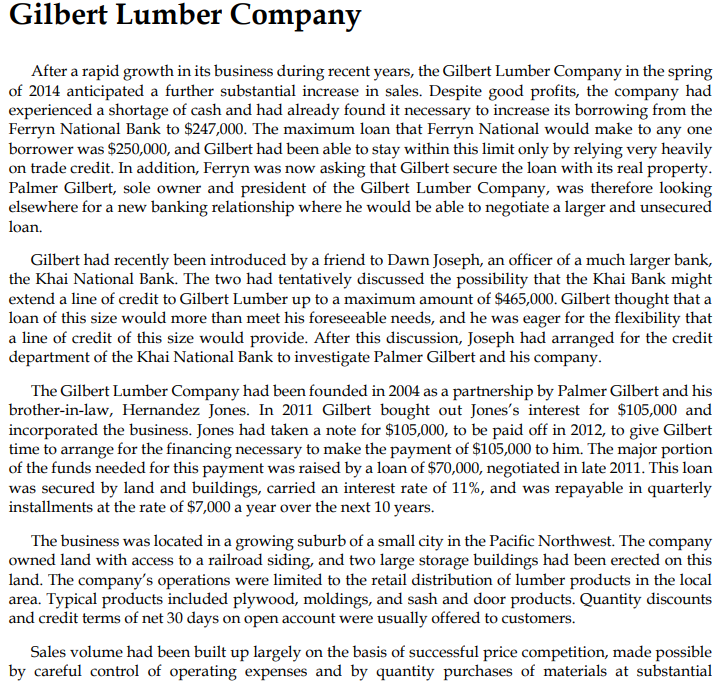
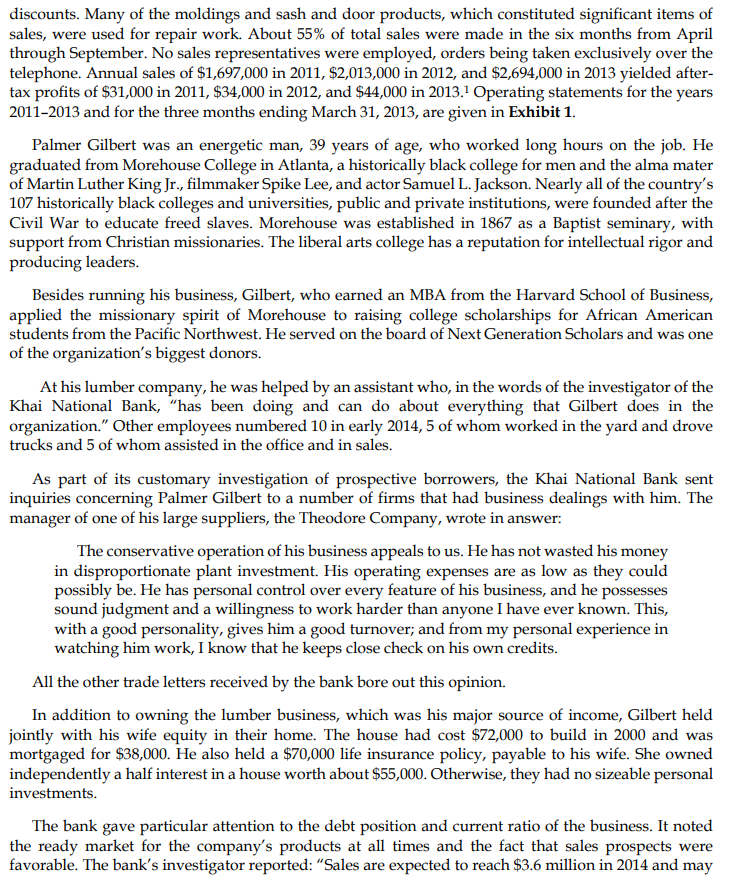

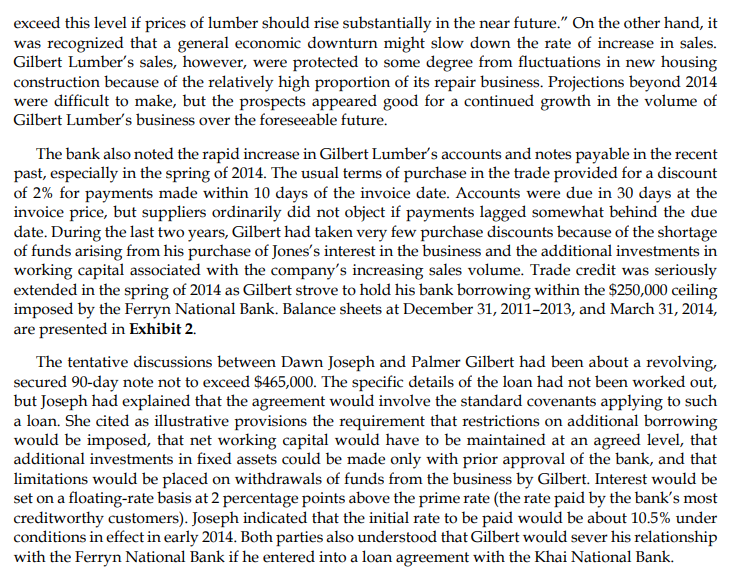
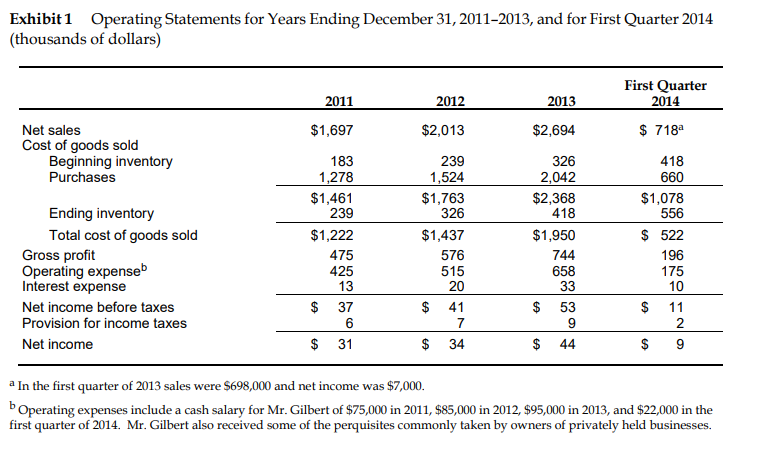
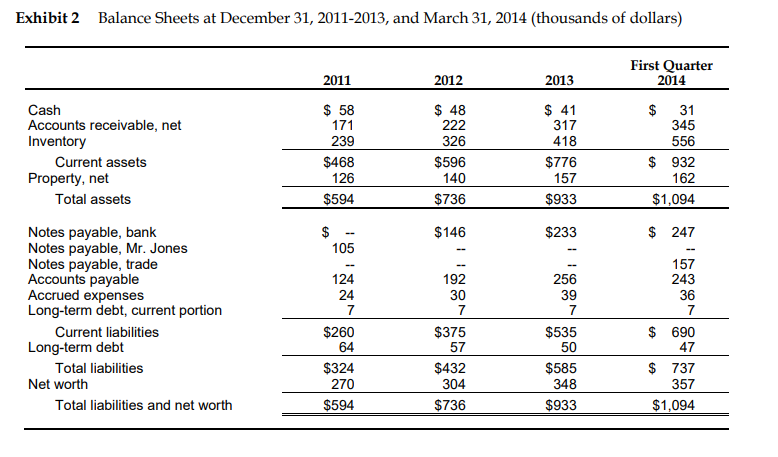
(1) Why has Gilbert Lumber borrowed increasing amounts despite its consistent profitability? How has Mr. Gilbert met the financing needs of the company during the period 2011 through 2013? Prepare the Statements of Cash Flows to assess the cash inflows and outflows over the years.
(2) Has the financial strength of Gilbert Lumber improved or deteriorated? Conduct time-series analysis of financial ratios to assess the trend of financial condition over the years.
(3) Do you agree with Mr. Gilbert estimate of the company's loan requirements? How much will he need to finance the expected expansion in sales to $4.0 million in 2014 (instead of 3.6 million stated in the case) with and without taking the 2% trade discounts? Prepare pro forma income statements and balance sheets for the two scenarios.
(4) As Mr. Gilbert's financial adviser, would you urge him to go ahead with, or to reconsider, his anticipated expansion and his plans for additional debt financing? As the banker, would you approve Mr. Gilbert's loan request, and if so, what conditions would you put on the loan?
Gilbert Lumber Company After a rapid growth in its business during recent years, the Gilbert Lumber Company in the spring of 2014 anticipated a further substantial increase in sales. Despite good profits, the company had experienced a shortage of cash and had already found it necessary to increase its borrowing from the Ferryn National Bank to $247,000. The maximum loan that Ferryn National would make to any one borrower was $250,000, and Gilbert had been able to stay within this limit only by relying very heavily on trade credit. In addition, Ferryn was now asking that Gilbert secure the loan with its real property. Palmer Gilbert, sole owner and president of the Gilbert Lumber Company, was therefore looking elsewhere for a new banking relationship where he would be able to negotiate a larger and unsecured loan. Gilbert had recently been introduced by a friend to Dawn Joseph, an officer of a much larger bank, the Khai National Bank. The two had tentatively discussed the possibility that the Khai Bank might extend a line of credit to Gilbert Lumber up to a maximum amount of $465,000. Gilbert thought that a loan of this size would more than meet his foreseeable needs, and he was eager for the flexibility that a line of credit of this size would provide. After this discussion, Joseph had arranged for the credit department of the Khai National Bank to investigate Palmer Gilbert and his company. The Gilbert Lumber Company had been founded in 2004 as a partnership by Palmer Gilbert and his brother-in-law, Hernandez Jones. In 2011 Gilbert bought out Jones's interest for $105,000 and incorporated the business. Jones had taken a note for $105,000, to be paid off in 2012, to give Gilbert time to arrange for the financing necessary to make the payment of $105,000 to him. The major portion of the funds needed for this payment was raised by a loan of $70,000, negotiated in late 2011. This loan was secured by land and buildings, carried an interest rate of 11%, and was repayable in quarterly installments at the rate of $7,000 a year over the next 10 years. The business was located in a growing suburb of a small city in the Pacific Northwest. The company owned land with access to a railroad siding, and two large storage buildings had been erected on this land. The company's operations were limited to the retail distribution of lumber products in the local area. Typical products included plywood, moldings, and sash and door products. Quantity discounts and credit terms of net 30 days on open account were usually offered to customers. Sales volume had been built up largely on the basis of successful price competition, made possible by careful control of operating expenses and by quantity purchases of materials at substantial discounts. Many of the moldings and sash and door products, which constituted significant items of sales, were used for repair work. About 55% of total sales were made in the six months from April through September. No sales representatives were employed, orders being taken exclusively over the telephone. Annual sales of $1,697,000 in 2011, $2,013,000 in 2012, and $2,694,000 in 2013 yielded after- tax profits of $31,000 in 2011, $34,000 in 2012, and $44,000 in 2013. Operating statements for the years 2011-2013 and for the three months ending March 31, 2013, are given in Exhibit 1. Palmer Gilbert was an energetic man, 39 years of age, who worked long hours on the job. He graduated from Morehouse College in Atlanta, a historically black college for men and the alma mater of Martin Luther King Jr., filmmaker Spike Lee, and actor Samuel L. Jackson. Nearly all of the country's 107 historically black colleges and universities, public and private institutions, were founded after the Civil War to educate freed slaves. Morehouse was established in 1867 as a Baptist seminary, with support from Christian missionaries. The liberal arts college has a reputation for intellectual rigor and producing leaders. Besides running his business, Gilbert, who earned an MBA from the Harvard School of Business, applied the missionary spirit of Morehouse to raising college scholarships for African American students from the Pacific Northwest. He served on the board of Next Generation Scholars and was one of the organization's biggest donors. At his lumber company, he was helped by an assistant who, in the words of the investigator of the Khai National Bank, "has been doing and can do about everything that Gilbert does in the organization." Other employees numbered 10 in early 2014, 5 of whom worked in the yard and drove trucks and 5 of whom assisted in the office and in sales. As part of its customary investigation of prospective borrowers, the Khai National Bank sent inquiries concerning Palmer Gilbert to a number of firms that had business dealings with him. The manager of one of his large suppliers, the Theodore Company, wrote in answer: The conservative operation of his business appeals to us. He has not wasted his money in disproportionate plant investment. His operating expenses are as low as they could possibly be. He has personal control over every feature of his business, and he possesses sound judgment and a willingness to work harder than anyone I have ever known. This, with a good personality, gives him a good turnover; and from my personal experience in watching him work, I know that he keeps close check on his own credits. All the other trade letters received by the bank bore out this opinion. In addition to owning the lumber business, which was his major source of income, Gilbert held jointly with his wife equity in their home. The house had cost $72,000 to build in 2000 and was mortgaged for $38,000. He also held a $70,000 life insurance policy, payable to his wife. She owned independently a half interest in a house worth about $55,000. Otherwise, they had no sizeable personal investments. The bank gave particular attention to the debt position and current ratio of the business. It noted the ready market for the company's products at all times and the fact that sales prospects were favorable. The bank's investigator reported: "Sales are expected to reach $3.6 million in 2014 and may 1 Sales in 2009 and 2010 amounted to $728,000 and $1,103,000, respectively, profit data for these years are not comparable with those of 2011 and later years because of the shift from a partnership to a corporate form of organization. As a corporation, Gilbert was taxed at the rate of 15% on its first $50,000 of income, 25% on the next $25,000 of income, and 34% on all additional income above $75,000 exceed this level if prices of lumber should rise substantially in the near future. On the other hand, it was recognized that a general economic downturn might slow down the rate of increase in sales. Gilbert Lumber's sales, however, were protected to some degree from fluctuations in new housing construction because of the relatively high proportion of its repair business. Projections beyond 2014 were difficult to make, but the prospects appeared good for a continued growth in the volume of Gilbert Lumber's business over the foreseeable future. The bank also noted the rapid increase in Gilbert Lumber's accounts and notes payable in the recent past, especially in the spring of 2014. The usual terms of purchase in the trade provided for a discount of 2% for payments made within 10 days of the invoice date. Accounts were due in 30 days at the invoice price, but suppliers ordinarily did not object if payments lagged somewhat behind the due date. During the last two years, Gilbert had taken very few purchase discounts because of the shortage of funds arising from his purchase of Jones's interest in the business and the additional investments in working capital associated with the company's increasing sales volume. Trade credit was seriously extended in the spring of 2014 as Gilbert strove to hold his bank borrowing within the $250,000 ceiling imposed by the Ferryn National Bank. Balance sheets at December 31, 2011-2013, and March 31, 2014, are presented in Exhibit 2. The tentative discussions between Dawn Joseph and Palmer Gilbert had been about a revolving, secured 90-day note not to exceed $465,000. The specific details of the loan had not been worked out, but Joseph had explained that the agreement would involve the standard covenants applying to such a loan. She cited as illustrative provisions the requirement that restrictions on additional borrowing would be imposed, that net working capital would have to be maintained at an agreed level, that additional investments in fixed assets could be made only with prior approval of the bank, and that limitations would be placed on withdrawals of funds from the business by Gilbert. Interest would be set on a floating-rate basis at 2 percentage points above the prime rate (the rate paid by the bank's most creditworthy customers). Joseph indicated that the initial rate to be paid would be about 10.5% under conditions in effect in early 2014. Both parties also understood that Gilbert would sever his relationship with the Ferryn National Bank if he entered into a loan agreement with the Khai National Bank. Exhibit1 Operating Statements for Years Ending December 31, 2011-2013, and for First Quarter 2014 (thousands of dollars) First Quarter 2014 2011 2012 2013 $1,697 $2,013 $2,694 $ 718a Net sales Cost of goods sold Beginning inventory Purchases Ending inventory Total cost of goods sold Gross profit Operating expenseb Interest expense Net income before taxes Provision for income taxes Net income 183 1,278 $1,461 239 $1,222 475 425 13 $ 37 6 $ 31 239 1,524 $1,763 326 $1,437 576 515 20 $ 41 7 $ 34 326 2,042 $2,368 418 $1,950 744 658 33 $ 53 9 $ 44 418 660 $1,078 556 $ 522 196 175 10 $ 11 2 $ 9 a In the first quarter of 2013 sales were $698,000 and net income was $7,000. Operating expenses include a cash salary for Mr. Gilbert of $75,000 in 2011, $85,000 in 2012, $95,000 in 2013, and $22,000 in the first quarter of 2014. Mr. Gilbert also received some of the perquisites commonly taken by owners of privately held businesses. Exhibit 2 Balance Sheets at December 31, 2011-2013, and March 31, 2014 (thousands of dollars) 2011 First Quarter 2014 2012 2013 Cash Accounts receivable, net Inventory Current assets Property, net Total assets $ 58 171 239 $468 126 $594 $ 48 222 326 $596 140 $736 $ 41 317 418 $776 157 $933 $ 31 345 556 $ 932 162 $1,094 $ $146 $233 $ 247 105 Notes payable, bank Notes payable, Mr. Jones Notes payable, trade Accounts payable Accrued expenses Long-term debt, current portion Current liabilities Long-term debt Total liabilities Net worth Total liabilities and net worth 124 24 7 $260 64 $324 270 $594 192 30 7 $375 57 $432 304 $736 256 39 7 $535 50 $585 348 $933 157 243 36 7 $ 690 47 $ 737 357 $1,094 Gilbert Lumber Company After a rapid growth in its business during recent years, the Gilbert Lumber Company in the spring of 2014 anticipated a further substantial increase in sales. Despite good profits, the company had experienced a shortage of cash and had already found it necessary to increase its borrowing from the Ferryn National Bank to $247,000. The maximum loan that Ferryn National would make to any one borrower was $250,000, and Gilbert had been able to stay within this limit only by relying very heavily on trade credit. In addition, Ferryn was now asking that Gilbert secure the loan with its real property. Palmer Gilbert, sole owner and president of the Gilbert Lumber Company, was therefore looking elsewhere for a new banking relationship where he would be able to negotiate a larger and unsecured loan. Gilbert had recently been introduced by a friend to Dawn Joseph, an officer of a much larger bank, the Khai National Bank. The two had tentatively discussed the possibility that the Khai Bank might extend a line of credit to Gilbert Lumber up to a maximum amount of $465,000. Gilbert thought that a loan of this size would more than meet his foreseeable needs, and he was eager for the flexibility that a line of credit of this size would provide. After this discussion, Joseph had arranged for the credit department of the Khai National Bank to investigate Palmer Gilbert and his company. The Gilbert Lumber Company had been founded in 2004 as a partnership by Palmer Gilbert and his brother-in-law, Hernandez Jones. In 2011 Gilbert bought out Jones's interest for $105,000 and incorporated the business. Jones had taken a note for $105,000, to be paid off in 2012, to give Gilbert time to arrange for the financing necessary to make the payment of $105,000 to him. The major portion of the funds needed for this payment was raised by a loan of $70,000, negotiated in late 2011. This loan was secured by land and buildings, carried an interest rate of 11%, and was repayable in quarterly installments at the rate of $7,000 a year over the next 10 years. The business was located in a growing suburb of a small city in the Pacific Northwest. The company owned land with access to a railroad siding, and two large storage buildings had been erected on this land. The company's operations were limited to the retail distribution of lumber products in the local area. Typical products included plywood, moldings, and sash and door products. Quantity discounts and credit terms of net 30 days on open account were usually offered to customers. Sales volume had been built up largely on the basis of successful price competition, made possible by careful control of operating expenses and by quantity purchases of materials at substantial discounts. Many of the moldings and sash and door products, which constituted significant items of sales, were used for repair work. About 55% of total sales were made in the six months from April through September. No sales representatives were employed, orders being taken exclusively over the telephone. Annual sales of $1,697,000 in 2011, $2,013,000 in 2012, and $2,694,000 in 2013 yielded after- tax profits of $31,000 in 2011, $34,000 in 2012, and $44,000 in 2013. Operating statements for the years 2011-2013 and for the three months ending March 31, 2013, are given in Exhibit 1. Palmer Gilbert was an energetic man, 39 years of age, who worked long hours on the job. He graduated from Morehouse College in Atlanta, a historically black college for men and the alma mater of Martin Luther King Jr., filmmaker Spike Lee, and actor Samuel L. Jackson. Nearly all of the country's 107 historically black colleges and universities, public and private institutions, were founded after the Civil War to educate freed slaves. Morehouse was established in 1867 as a Baptist seminary, with support from Christian missionaries. The liberal arts college has a reputation for intellectual rigor and producing leaders. Besides running his business, Gilbert, who earned an MBA from the Harvard School of Business, applied the missionary spirit of Morehouse to raising college scholarships for African American students from the Pacific Northwest. He served on the board of Next Generation Scholars and was one of the organization's biggest donors. At his lumber company, he was helped by an assistant who, in the words of the investigator of the Khai National Bank, "has been doing and can do about everything that Gilbert does in the organization." Other employees numbered 10 in early 2014, 5 of whom worked in the yard and drove trucks and 5 of whom assisted in the office and in sales. As part of its customary investigation of prospective borrowers, the Khai National Bank sent inquiries concerning Palmer Gilbert to a number of firms that had business dealings with him. The manager of one of his large suppliers, the Theodore Company, wrote in answer: The conservative operation of his business appeals to us. He has not wasted his money in disproportionate plant investment. His operating expenses are as low as they could possibly be. He has personal control over every feature of his business, and he possesses sound judgment and a willingness to work harder than anyone I have ever known. This, with a good personality, gives him a good turnover; and from my personal experience in watching him work, I know that he keeps close check on his own credits. All the other trade letters received by the bank bore out this opinion. In addition to owning the lumber business, which was his major source of income, Gilbert held jointly with his wife equity in their home. The house had cost $72,000 to build in 2000 and was mortgaged for $38,000. He also held a $70,000 life insurance policy, payable to his wife. She owned independently a half interest in a house worth about $55,000. Otherwise, they had no sizeable personal investments. The bank gave particular attention to the debt position and current ratio of the business. It noted the ready market for the company's products at all times and the fact that sales prospects were favorable. The bank's investigator reported: "Sales are expected to reach $3.6 million in 2014 and may 1 Sales in 2009 and 2010 amounted to $728,000 and $1,103,000, respectively, profit data for these years are not comparable with those of 2011 and later years because of the shift from a partnership to a corporate form of organization. As a corporation, Gilbert was taxed at the rate of 15% on its first $50,000 of income, 25% on the next $25,000 of income, and 34% on all additional income above $75,000 exceed this level if prices of lumber should rise substantially in the near future. On the other hand, it was recognized that a general economic downturn might slow down the rate of increase in sales. Gilbert Lumber's sales, however, were protected to some degree from fluctuations in new housing construction because of the relatively high proportion of its repair business. Projections beyond 2014 were difficult to make, but the prospects appeared good for a continued growth in the volume of Gilbert Lumber's business over the foreseeable future. The bank also noted the rapid increase in Gilbert Lumber's accounts and notes payable in the recent past, especially in the spring of 2014. The usual terms of purchase in the trade provided for a discount of 2% for payments made within 10 days of the invoice date. Accounts were due in 30 days at the invoice price, but suppliers ordinarily did not object if payments lagged somewhat behind the due date. During the last two years, Gilbert had taken very few purchase discounts because of the shortage of funds arising from his purchase of Jones's interest in the business and the additional investments in working capital associated with the company's increasing sales volume. Trade credit was seriously extended in the spring of 2014 as Gilbert strove to hold his bank borrowing within the $250,000 ceiling imposed by the Ferryn National Bank. Balance sheets at December 31, 2011-2013, and March 31, 2014, are presented in Exhibit 2. The tentative discussions between Dawn Joseph and Palmer Gilbert had been about a revolving, secured 90-day note not to exceed $465,000. The specific details of the loan had not been worked out, but Joseph had explained that the agreement would involve the standard covenants applying to such a loan. She cited as illustrative provisions the requirement that restrictions on additional borrowing would be imposed, that net working capital would have to be maintained at an agreed level, that additional investments in fixed assets could be made only with prior approval of the bank, and that limitations would be placed on withdrawals of funds from the business by Gilbert. Interest would be set on a floating-rate basis at 2 percentage points above the prime rate (the rate paid by the bank's most creditworthy customers). Joseph indicated that the initial rate to be paid would be about 10.5% under conditions in effect in early 2014. Both parties also understood that Gilbert would sever his relationship with the Ferryn National Bank if he entered into a loan agreement with the Khai National Bank. Exhibit1 Operating Statements for Years Ending December 31, 2011-2013, and for First Quarter 2014 (thousands of dollars) First Quarter 2014 2011 2012 2013 $1,697 $2,013 $2,694 $ 718a Net sales Cost of goods sold Beginning inventory Purchases Ending inventory Total cost of goods sold Gross profit Operating expenseb Interest expense Net income before taxes Provision for income taxes Net income 183 1,278 $1,461 239 $1,222 475 425 13 $ 37 6 $ 31 239 1,524 $1,763 326 $1,437 576 515 20 $ 41 7 $ 34 326 2,042 $2,368 418 $1,950 744 658 33 $ 53 9 $ 44 418 660 $1,078 556 $ 522 196 175 10 $ 11 2 $ 9 a In the first quarter of 2013 sales were $698,000 and net income was $7,000. Operating expenses include a cash salary for Mr. Gilbert of $75,000 in 2011, $85,000 in 2012, $95,000 in 2013, and $22,000 in the first quarter of 2014. Mr. Gilbert also received some of the perquisites commonly taken by owners of privately held businesses. Exhibit 2 Balance Sheets at December 31, 2011-2013, and March 31, 2014 (thousands of dollars) 2011 First Quarter 2014 2012 2013 Cash Accounts receivable, net Inventory Current assets Property, net Total assets $ 58 171 239 $468 126 $594 $ 48 222 326 $596 140 $736 $ 41 317 418 $776 157 $933 $ 31 345 556 $ 932 162 $1,094 $ $146 $233 $ 247 105 Notes payable, bank Notes payable, Mr. Jones Notes payable, trade Accounts payable Accrued expenses Long-term debt, current portion Current liabilities Long-term debt Total liabilities Net worth Total liabilities and net worth 124 24 7 $260 64 $324 270 $594 192 30 7 $375 57 $432 304 $736 256 39 7 $535 50 $585 348 $933 157 243 36 7 $ 690 47 $ 737 357 $1,094Step by Step Solution
There are 3 Steps involved in it
Step: 1

Get Instant Access to Expert-Tailored Solutions
See step-by-step solutions with expert insights and AI powered tools for academic success
Step: 2

Step: 3

Ace Your Homework with AI
Get the answers you need in no time with our AI-driven, step-by-step assistance
Get Started


